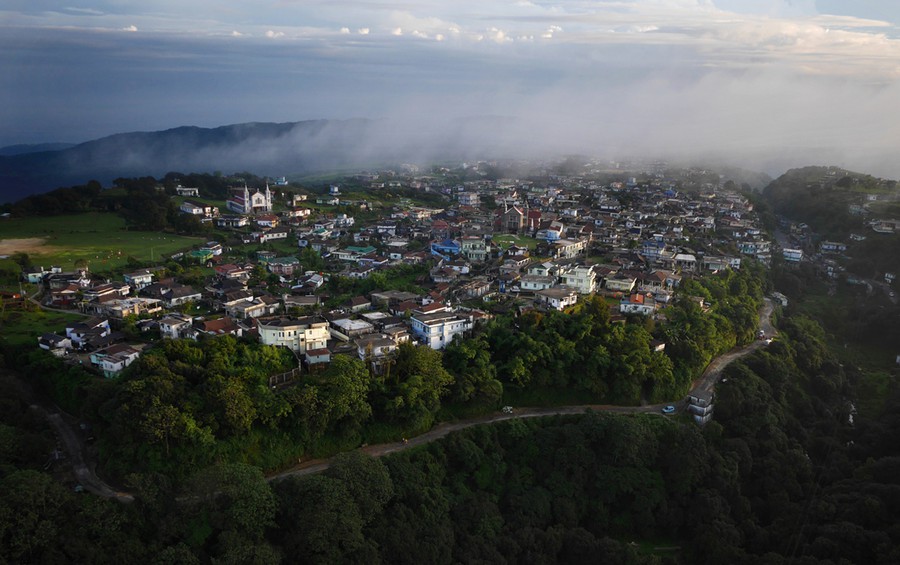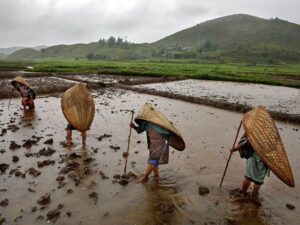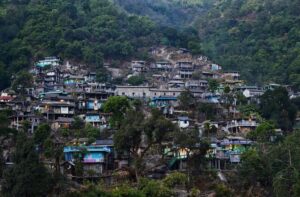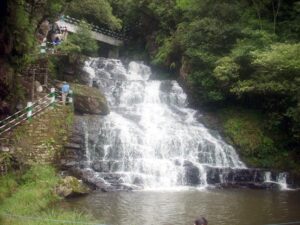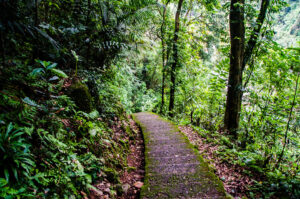Mesmerising Mawsynram
Shillong, largest city and capital of Meghalaya, retains its colonial-era charm, with a home-brewed brand of Western music, gracious cafés and friendly people. But, the former capital of undivided Assam bursts at its seams, thanks to hordes of tourists who arrive to escape the heat of the plains and catch a glimpse of the monsoon. When tourists are done exploring its quieter suburbs, crowded with clusters of pine and rhododendron, they often push on to discover the sacred groves at Mawphlang, the root bridges at Nongriat, Asia’s cleanest village at Mawlynnong, the underground caves at Mawjymbuin and the drizzly hills of Mawsynram.
Cascading waterfalls, unstoppable pouring of rain and valleys carpeted with lush greenery are some of the features of Mawsynram, a tiny village on the eastern part of the Khasi Hills. Known as the wettest place in India, Mawsynram receives an annual rainfall of almost 12 metres and is a popular hill station among tourists.
Road to Mawsynram
Each year, for over four months, slanting drops of rain slam the sodden earth like iridescent sheets of gunfire. They beat a steady drumroll on the houses scattered across the countryside. They glisten on the brown cows that stand as stock-still as the rocks. A pillar of cloud often leads the vehicle one is travelling in on a misty road that snakes into the distance.
The wheels crunch over gravel and whirr through red mud as 26-year-old Rafelong, the Coldplay-loving taxi driver from Shillong, drives us to Mawsynram, about 60 km south of Shillong.
The road to Mawsynram is beautiful, but the drifts of rain and spray from the innumerable gushing waterfalls that line it, and sometimes wash over it, lead to poor visibility. Bamboo-splints divert water to the fields where farmers in wellingtons (knee-high boots) and knups – a tortoise shell-shaped shield made of grass and bamboo used as rain cover – are taking a bidi (locally manufactured cigarette) break from turning over clods of earth.
The countryside is an immodest green and frogs peep from under huge Jurassic-era ferns. Young men kick a ball covered in slush into the goalpost on a field.
While we were still hooked on to the overwhelming scenes outside; our car stops and we get down for a quick lunch at a lace-curtained roadside restaurant. Soon, an old lady comes out with rice with mashed potato, some chicken and some locally made rice cakes for dessert. The steam from the food mixes with the fog outside as we hungrily gulp down every bite. “After this, we drive through forests,” says Rafelong. An hour later, we arrive at Mawsynram.
The bright green landscape with colourful orchids welcomes the tourists soon as they cross the post that reads ‘Welcome to Mawsynram’.
As the car moves and starts to climb, the driver points to a distant saddle in the hills where the road passes through. As the road progresses we gain altitude and are soon surrounded by misty green and blue hills. Now we can spot a lot of greenery around us.
The whole village is dotted with colourful houses and from a distance; almost glittering, snow-capped mountain peaks are visible. The region is not just a treat to the eyes only but also to the ears. One can easily hear the roaring waterfalls and small birds chirping in the orchid fields every now and then.
The ideal time to visit Mawsynram is during the monsoon when the beauty of the region is in full bloom – the air remains clean and fresh, the leaves bright and green and the whole atmosphere tranquil. However, the region can be visited at any time of the year since the weather is pleasant and is rarely hot. The average temperature is 10ºC during the month of January and reaches only 20ºC during August.
Natural tourist attractions
The prime tourist attraction in Mawsynram is the botanical garden located at a quiet yet breath-taking spot. Several varieties of exotic and indigenous plants can be viewed at the garden. The site even houses a small scale aviary that boasts of a variety of colourful and exotic bird species.
One of the most underrated tourist attractions of Mawsynram is Dwarksuid, a charming pool with sprawling, rocky banks. The rock formations in the region are unforgettable due to their unique lotus-like shape. For those looking for some adventure as well as spiritual significance in the region, Mawjymbuin Caves are the best place to go. Containing a pair of speleothems that have been moulded by nature into the shape of a Shivalinga, has been a hotspot for religious tourists.
The Symper Rock is a common tourist destination and is a rocky dome in the form of a loaf with an almost flat top. From the top of Symper Rock, tourists can expect to see the surrounding valleys and hills and the plains as well as the swift-flowing rivers in Bangladesh.
The Elephant Falls is another must-visit for anyone travelling to the village. It has three steps. Water comes out of the thick foliage and flows down against the black rocks. One can climb down through the stone steps cut out of the rock and go to the bottom seeing all three steps. There is a nicely landscaped park at the bottom. Legend has it that there was a rock shaped like an elephant beside the fall and thus the British had named it as Elephant Falls. The stone was destroyed in an earthquake in the year 1897, but the name stuck on. Fishing, boating and other water-based activities are also popular here.
Unfortunately, during the monsoons, Noh Kalilai, the largest waterfall of that region and also the fourth highest fall in the world, often floods the nearby areas and hence tourists are not allowed to go near the fall. Mawsynram is home to world’s longest sandstone cave, Krem Puri which is not accessible during the monsoons either as the surface becomes extremely damp and slippery, often causing minor accidents.
The lively village life
People of Mawsynram are known for their warm and friendly nature. Villagers greet visitors by offering tea, locally named Kwai and will offer you shelters to rest.
One can witness the typical lifestyle of the Khasi tribes at any time during the day. A usual small market place is laden with wooden cottages with grocery shops in front, butcher shops selling meat, men ready to go to their fields and women going about on their daily chores. These are the usual sights of villages in hills. But the area, still, is sparsely populated.
Due to the influx of large groups of tourists every season, the region has undergone rapid development in the past few years. It is now easy for tourists to find accommodation at the different hotels in Mawsynram. Small convenience stores and restaurants can be found in the village. Sometimes markets convene in the area, selling local products and tribal jewellery to tourists.
Rainy evening in the hills
As the day swiftly turns into evening and then night, the air turns colder, even though laden with moisture that hangs heavy. In the distance, I can spot bulbous clouds building upon the face of the hills. White clouds slowly turn dark and appear in different shapes, signalling impending rain.
It almost seemed like famous lines by the eminent Bengali Poet Shakti Chattopadhyay from one of his most revered poem Abani Bari Aacho (Abani, are you home), had come true. “It rains here, every month, round the year; Here the clouds roam like cows” it reads.
Tussocks of grass are thrown over the town’s tin roofs to lessen the noise of the maddening drizzle. We climb down a hillside and lose our footing on the moss-lined steps. We all stand drenched, clutching handfuls of wet grass, feeling like one of the characters in a Jack London novel who wants to lie down and let the wolves pick her bones. Just then, a local tea stall owner calls us and gets a few umbrellas for us, while inviting us for cups of tea and the same rice cake we had for lunch.
As we continue to look outside, a few raindrops leaking down the damp, make-shift roof of the tea-stall, drops into the teacups we hold.
“It rains here every day. When you open your doors in the morning tomorrow, clouds will come inside the room,” explains the tea-stall owner.
It rains for the rest of the night, till the wee hours of the next day. Still snuggled up in fuzzy blankets till noon, we open our doors and a thick layer of cloud seized us. Two hours later, we bid goodbye to the wettest place on Earth.

